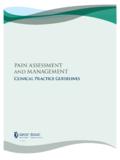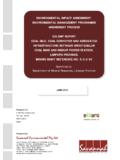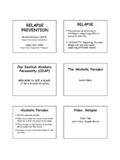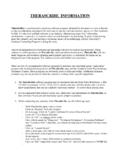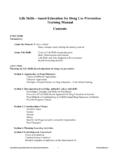Transcription of UNDERSTANDING AND TREATING THE EXPLOSIVE CHILD
1 UNDERSTANDING ANDTREATING THE EXPLOSIVE CHILDGABRIELLE LAWRENCE, Lawrence, 2010 OUTLINE Defining EXPLOSIVE Disruptive Behavior Disorder Identifying the causes of DBD Early attachment and impact of loss on DBD How we manage feelings Intake assessment of the EXPLOSIVE CHILD TREATING the DBD CHILD using play therapy Coaching for parents of EXPLOSIVE childrenGabrielle Lawrence, 2010 Disruptive Behavior Disorders in children are characterized by poor social relationships due to extremes of aggressiveness, lying, defiance, irritability, blaming others, cruelty, stealing, destructiveness, and Lawrence, 2010 CHARACTERISTICS OF THE INFLEXIBLE- EXPLOSIVE / BEHAVIOR DISORDERD CHILLD Limited capacity for flexibility and adaptability and incoherence in the midst of severe frustration An extremely low frustration threshold An extremely low tolerance for frustration The tendency to think in a concrete, rigid, black-and-white manner, can be very stubborn.
2 The persistence of inflexibility and poor response even when faced with severe consequences Inflexible episodes may have an out-of-the-blue quality May have a combination of diagnoses Falls completely apart under stress Gabrielle Lawrence, 2010 DISRUPTIVE MOOD DISORDER (DMD) Disruptive Behavior Disorders ( ) Conduct Disorder ( ) Bipolar Disorder ( , , Depressive Disorders ( , , 311) Attention-Deficit Hyperactivity Disorders ( ) Oppositional Defiant Disorder ( ) Conduct Disorder ( ) Generalized Anxiety Disorder ( ) Separation Anxiety Disorder ( ) Obsessive-Compulsive Disorder Tourette s Syndrome ) Post Traumatic Stress Disorder ( ) Acute Stress Disorder ( ) Reactive Attachment Disorder ( ) Bereavement ( )
3 Pervasive Developmental DisorderGabrielle Lawrence, 201069% CO-MORBIDITY OF DBDWITH MOOD, ANXIETY AND/OR OBSESSIVE COMPULSIVE DISORDERSG abrielle Lawrence, 2010 THE CAUSES OF DISRUPTIVED BEHAVIOR DISORDER Neurological based organic/ chemical deficiency Pervasive developmental disorder ADHD ODD/CD Bipolar/ mood disorder Anxiety disorder Environmentally Created Failure to attach to attachment figure Disrupted attachment Inappropriate parent CHILD relationship abuse /neglect Environmental problem other than with parent school, social, other adultsGabrielle Lawrence, 2010 Why Do Children Get Angry? Their anger is the only voice they have They feel helpless in their environment They do not know how to tell parents and others that they are: Afraid-Frustrated Hurting-Feeling unloved lonely -Isolated Embarrassed -Wanting closeness Grieving-Developmentally AfraidDelayed and can t Chemical function like otherImbalancechildrenGabrielle Lawrence, 2010 Why Do Children Get Angry?
4 UNDERSTANDING he or she wants to comply but can not due to a developmental delay which cause problems with: Flexibility Adaptability Problem-solving Frustration ToleranceRoss Greene, Lawrence, 2010 Challenging behaviors occur when the demands of the environment exceed a CHILD s capacity to respond adaptively Collaborative problem-solving is required ROSS GREENE, PROBLEM-SOLVING MODELWhy Do Children Get Angry?Gabrielle Lawrence, 2010 assessment OF DBD Thorough assessment of:Developmental history Family history (mental health & attachment)Medical history Academic historyPeer relationship historyReferrals from other professionalsReferral for Medication Testing to Identify the source of the DBD * Neurologically or Environmentally based* Developmental delays, Sensory Processing Disorder, ADHD, Bipolar Disorder, OCDG abrielle Lawrence, 2010 TREATING EXPLOSIVE DISRUPTIVE BEHAVIOR DISORDED CHILDRENYOUR MOST IMPORTANT TOOL IS YOUR RELATIONSHIP WITH THE CHILDG abrielle Lawrence.
5 2010 COLABORATIVE PROBLEM-SOLVING Challenging behaviors occur when the demands of the environment exceed a CHILD s capacity to respond adaptively Collaborative problem solving is required Ross Greene, Lawrence, 2010 COLLABORATIVE PROBLEM SOLVING1)EMPATHYGOAL: To gather information from the CHILD about his or her concernsPARENT OR TEACHER: states the problematic behavior and simply asks the question: What s up? If the CHILD does not answer, the teacher waits and continues to non-judgmentally probe for the reason for thebehavior Ross Greene, Lawrence, 2010 COLLABORATIVE PROBLEM SOLVING2) DEFINING THE PROBLEMGOAL: For the parent/teacher to neutrally saying his concern and stating why: My concern Three categories of concern are: Safety, Learning, How problem behavior impacts othersRoss Greene, Lawrence, 2010 COLLABORATIVE PROBLEM SOLVING3) INVITATIONGOAL.
6 To brainstorm solutions together, to address both the parent/teacher s concerns and the CHILD s concerns and end with a win/win solutions that works for bothRoss Greene, Lawrence, 2010 KEY ELEMENTS FOR TREATINGEXPLOSIVE DBD CHILDREN TO FOSTER EMOTIONAL AWARENESS Recognizing physical changes that occur when anger begins Notice in the Hot and Cool systems:Face flushing, muscle tightening, getting emotional TO PRACTICE ANGER MANAGEMENT SKILLS Distraction: imagine you are doing fun stuff Deep breathing / relaxation Coping self-statements: As long as I keep my cool, I m in control It is not worth it to get angry Gabrielle Lawrence, 2010 KEY ELEMENTS FOR TREATINGEXPLOSIVE DBD CHILDREN TO PRACTICE SOCIAL PROBLEM SOLVING To identify triggers and potential problems To generate a range of possible solutions To evaluate the the likely consequences Decide what you would like to have happen instead Think how that would feelLochman, Boxmeyer& Powell (2009)
7 Gabrielle Lawrence, 2010 WORKING WITH PARENTS Work with parents to a create safe, usable structured and nurturing environment for the CHILD Teach parents Collaborative Problem-solving Teach parents to do empathic listening Teach parent good parenting skills & Filial Play Therapy, PCIT and Floor time Create a family plan for good joint parenting Teach parenting that has good balance of structure and nurture Gabrielle Lawrence, 2010 FORMULA HEALING LOSS ACKNOWLEDGES tate the facts about the anger causing event EMPATHIZES tates the CHILD s feelings SOOTHC onsole, make amends,assure, nurture IDENTIFY NEW COPINGHelp the CHILD find new ways to dealing with the the difficult events and feelings 2007 Gabrielle Lawrence, , 480-607-5030 THE MAGIC FORMULA LOTS OF GOOD STRUCTURE LOTS OF GOOD NURTURING EQUALS = SAFETY FOR THE CHILDCOMPLIANT BEHAVIOR FROM HIM 2007 Gabrielle Lawrence, Lawrence, 2010 PARENTING PLAN FORMAT FOUR CATEGORIES OF RULES;SafetyCitizenship/ Good BehaviorLife SkillsSchool CONSEQUENCES REWARDSG abrielle Lawrence, 2010 Parenting Plan -4 to 12 yearsCitizenship/Behavior Conduct: no lying, no cheating, no arguing with parents,no whining, no disobeying, no screaming.
8 No name-calling,no hurting others, no hair pulling or pinching Responsibility : no blaming others. Respectful: Share. Personal Self-reliance: no trying to get others to take careof your responsibilities: if you need something get it yourself. Respect Belongings: Put things away. Share. Manners:, Use please and thank-you s No means No Do things when asked; Listen to parents When you go to bed, stay in bedSchool Maintain agreed upon GPA Homework completed before play Hand in homeworkSafety Always sit in car seats or boosters seats while under 80 pounds always buckle up Always wear bike helmets and pads while on bikes, skates, scooters, etc.
9 Do not go near a pool of water without an adult to watch Never leave house without telling parent where you are going If your safety is threatened inform a trusted adult Bedtime is 8pm Need 10 hours every night No TV watching in bed at bedtime. Bedtime is for sleeping only. Asleep by 8pm. All TV programs must be approved by parents. No TV programs after 8pm. No PG-13. PG is okay if previously reviewed by parent Sunscreen everyday. Re-applied every two hours if playing outside. Use stove only when supervised No playing in streetLife Skills Help with cooking, laundry,& cleaning Chores completed before play Personal Hygiene: Brush teeth twice a day, comb hair, bath Clean up your own messes: clear your plates from the table, put clothes into hamper, put toys away, make bed.
10 Keep room clean, care for pets Learn how to handle moneyConsequences Time out on chair or room Loss of TV privileges Loss of allowance Loss of object of desire (toys, computer) Discussion with parent on what was wrong and how to correct Apologize make amendsRewards Full Allowance Surprises (games, movies, clothing) An object of desire (gifts) A place of desire Win back privileges 2007 Gabrielle Lawrence, Lawrence, 2010 POSITIVE PARENT-CHILDSPECIAL TIME Praise the CHILD often Show interest ask questions Do not criticize or reprimand -no matter what happens Defer all Problems to a later time Avoid Controversial subjects Have fun just being together Allow the CHILD to choose the activity Participate fully in whatever activity that theychoose Lockman, Boxmeyer& Powell (2009)Gabrielle Lawrence, 2010 Gabrielle Lawrence, E.

